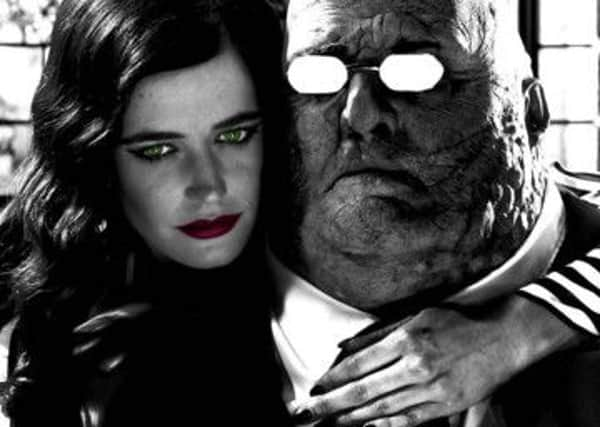Film review: Sin City: A Dame to Kill For


Sin City: A Dame to Kill For
Directed by: Robert Rodriguez, Frank Miller
Starring: Eva Green, Josh Brolin, Joseph Gordon-Levitt, Mickey Rourke, Stacy Keach
Star rating: **
With the eponymous locale a hotbed of vice and venality populated by misshapen men who talk like Mickey Spillane and ass-kicking dames who dress like hookers, Frank Miller’s hyper-violent graphic novels were strikingly translated to the big screen thanks to director Robert Rodriguez’s decision to use Miller’s panels not just as storyboards for the action, but as frame-by-frame aesthetic blueprints for the film’s entire look. Shot against green screen (with computer-generated backgrounds and effects added in later), the film replicated the way Miller used swathes of negative black space on the page to accentuate every twisted action of the characters on the screen – a digital upgrading, if you will, of film noir’s use of shadows and smoke to hem miscreant characters into pitiless worlds from which there’s never any real escape.
Advertisement
Hide AdNine years on, and with Miller having already exposed the limits of the technique with his own woeful adaptation of the The Spirit in 2008, Sin City: A Dame to Kill For offers up a belated reminder of what was interesting about the first film without really advancing the form in any significant way. Eschewing both the grounded approach of the Dark Knight films (which took their inspiration from Miller’s re-invention of Batman in the mid-1980s) and the poppy blockbuster approach of Marvel, it still delivers the most authentically outlandish cinematic replication of the comic book form. But shorn of its predecessor’s shock-of-the-new appeal, A Dame to Kill For is only fitfully engaging as a movie, its over-qualified cast occasionally managing to elevate material that too often slips into pulpy pastiche.
In this respect, Eva Green is very much the star of the show as the titular femme fatale, Ava Lord. Effectively playing her as an X-rated Lauren Bacall, she views her male assailants with withering contempt while using her frequently disrobed body as a weapon – both against the saps lining up to be her character’s saviour and the leering gaze of her directors, whom she exposes as a couple of retrogressive voyeurs far more comfortable trussing women up in fetish gear and stripper wear than giving an actress of her stature something interesting to sink her teeth into. Still, as she demonstrated in the recent 300: Rise of an Empire, Green does have a playful, vampy, wild-eyed presence that can elevate weak material, and she certainly makes the convoluted double, triple and quadruple crosses around which her segment revolves far more entertaining to watch than they would have been otherwise.
Among the other stories in this portmanteau, The Long Bad Night (one of two newly penned tales written specifically for the film) is the only one that really stands out thanks to a flinty Joseph Gordon-Levitt. Cast here as Johnny, a brilliant young card shark too blindsided by revenge to get out of town after winning big against Sin City’s most corrupt politician (the magnificent Powers Boothe, reprising his role from the first film), Gordon-Levitt has enough cocksure authority to enable him to carry off Miller’s faux hardboiled dialogue and narration without making him sound as if he’s auditioning for Bugsy Malone. His high-stakes poker game with Booth’s remorseless Senator Roark is also where Rodriguez’s visual flair and talent for creating tension in absurd situations coheres most effectively – and a later scene in which Johnny has to visit a back-alley doctor (played by Christopher Lloyd) is one of the few moments in which the film’s occasional attempts at sick humour pays off with a decent gag (this one involves haggling over the price of fixing some bent-out-of-shape fingers).
Unfortunately, the return of Mickey Rourke’s face-battered Marv and Jessica Alba’s stripper, Nancy, succeed only in bringing too much baggage from the first film, mostly in the form of “what was their deal?” style questions that aren’t always satisfactorily answered by a plot twist that sees Marv suffering from amnesia and Nancy haunted by the ghostly presence of Bruce Willis’ suicidal cop, Hartigan. This is not a sequel, in other words, that stands on its own. Josh Brolin, for instance, turns up as a character originally played by Clive Owen, but without knowing this you’d be hard-pressed to understand the significance of his relationship with Rosario Dawson, returning once again as the leader of a gang of vigilante hookers. It’s as if Miller and Rodriguez have over-estimated the first film’s lasting appeal. That was a movie that unashamedly, almost gloriously, celebrated the value of style over substance. But when there’s no real substance to the characters, it’s a bit much to ask audiences to recall their histories and back-stories, especially almost a decade on. Sin City: A Dame to Kill For has some style – just not enough to justify a return visit.